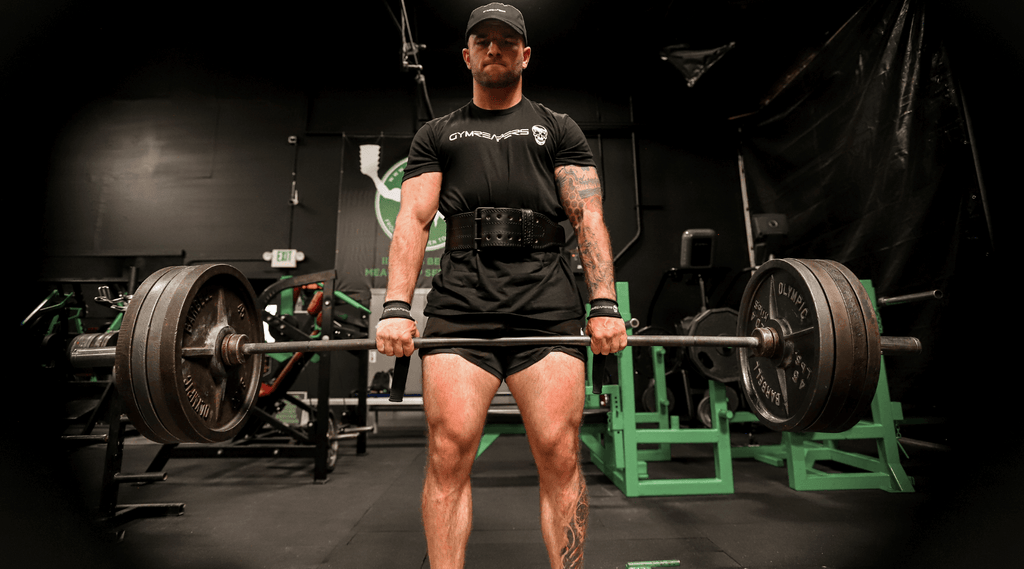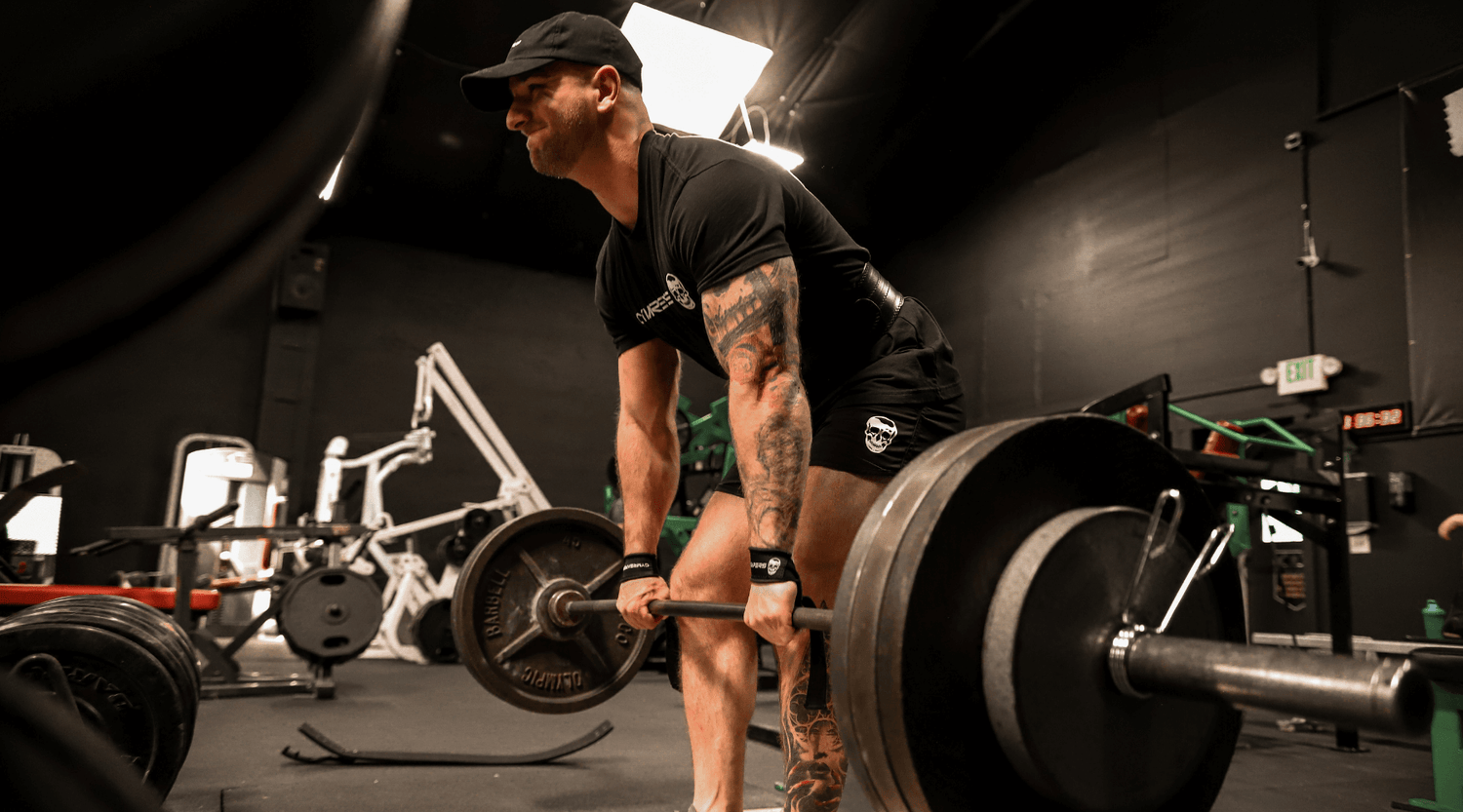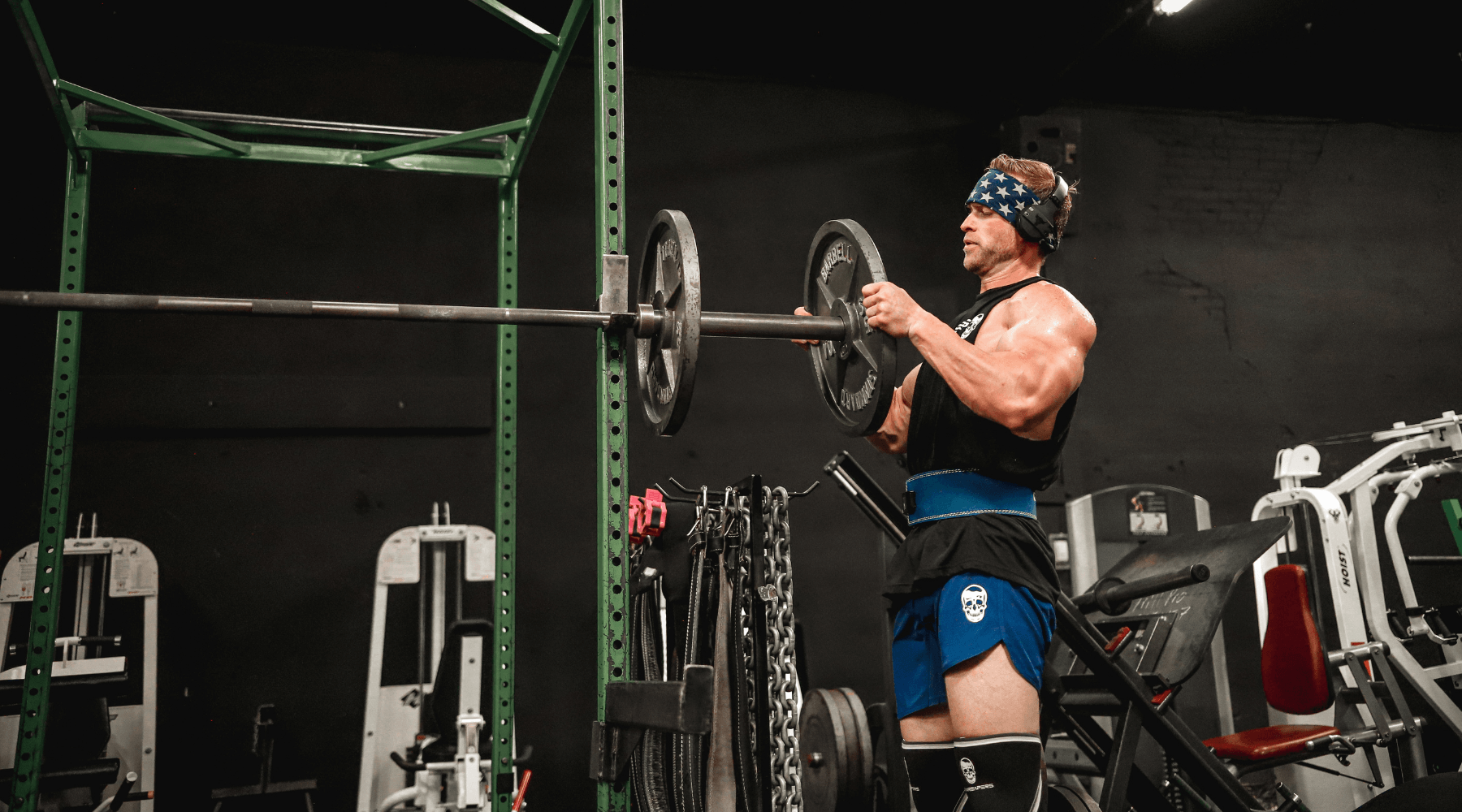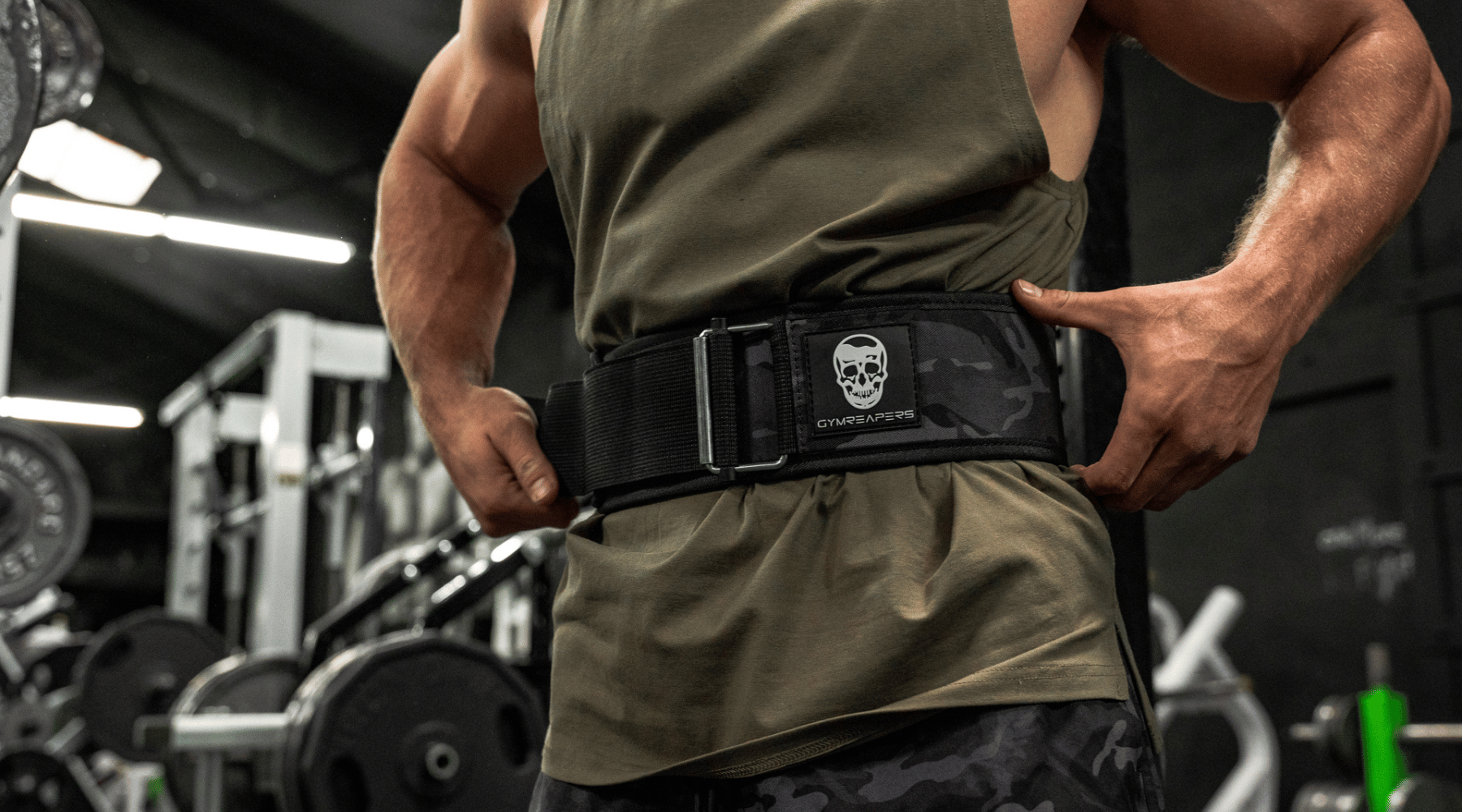The deadlift is one of the most essential movements which builds muscle and strength throughout your body. If you haven’t attempted this exercise yet or if you’re a little rusty, this post is a great reference point.
Before you attempt a deadlift, you should be knowledgeable about ways to avoid injury. Knowing the proper form, grip, deadlift benefits, and ways to avoid injury are all essential aspects of a good lift. In this guide, we’ll cover all of those important aspects.
The information in this guide will help lead you to strength and power that’ll transfer to other aspects of your fitness goals.
- How to Warm Up for Deadlifts
- How to Do the Deadlift
- Benefits of Deadlifting
- Muscles Worked When Deadlifting
- Common Deadlift Mistakes
- Best Grip for Deadlifting
- Deadlift Variations
- Deadlifting Gear

How to Warm Up for Deadlifts
A deadlift involves the recruitment of a lot of various muscle groups in your legs, hips, and even upper back. To be ready for a deadlift, a good warm-up is something that cannot be overlooked. As with any workout, it’s never a good idea to workout without stretching. There are several stretches you can do, but we picked out the top 3. Below are some ways you can mobilize your muscles.
Mobilizing the Ankles and Hips
Crouch down and step forward with your leg as if you were about to do a split squat. Make sure your front leg forms a 90-degree angle. Keep your core tight as you push on your front leg, either side to side or front to back to mobilize your ankle. Do this for 30 seconds and then switch legs.
Stretching your Hamstrings
You can perform this leg extension stretch laying on your back. Raise one leg and hold it up with your hands at thigh level. Focus on slowly kicking your leg straight up so that you elongate the hamstring and active. Perform the stretch on each leg for 15 to 20 reps.
Evaluate other Muscles
While you’re laying flat on the ground, the next stretch (sometimes called the dead bug) will help you loosen up your hips, core, and lats. While on your back, you’ll fully extend one leg and the opposite arm.
The purpose of this stretch is to evaluate your muscle groups for any tension. Then you can decide if you need to perform separate stretches for any specific tight muscles. It’s important to focus on your core muscles since they help provide stability as you perform deadlifts.
How to Do the Deadlift
You can deadlift in one of two ways: the conventional way (feet shoulder-width apart) or the sumo stance (feet wide). A conventional deadlift will also require you to have your hand grip outside of your legs, whereas in sumo your arm position will be inside your legs.
For this post, we’ll focus on the conventional deadlift. Below are the steps you should follow on how to do a deadlift (1).
The Setup
Again, your feet should be about shoulder-width apart and rooted to the floor. Your shins can touch the barbell and should remain vertical throughout the movement. Bring your shoulders over the bar and drive your glutes back and behind you.
Begin the Movement
To expand your stomach, take a breath in and then out to apply pressure to the core. If you’re wearing a weightlifting belt, it’ll be easier to push against it with your core.
Drive through the floor with your legs as you pick up the barbell. Keep the bar close to your body as you begin to lift the weight off the floor.
Finish the Movement
Once you reach standing position, contract your glutes, quads, and lats to lock out the deadlift. Maintain tension as you slowly start to decrease the weight. Hinge your hips back and maintain the same bar trajectory as you did with the upward movement.
On the deadlift descent, avoid hyperextending your back so you don't destroy your progress due to injury. Do this by pushing your hips backward and place the tension on your hamstrings. You’ve now completed the deadlift movement for one rep. You can test out your strength by performing 8-12 reps for 4 sets.

Benefits of the Deadlift
The deadlift is very common in most training programs and with good reason. There are a few key benefits of incorporating deadlifts into your training as well. Here are the top three benefits of doing deadlifts.
Improved Mobility
As we age, we tend to be more prone to back injuries. Deadlifting regularly with a moderate amount of weight helps reinforce proper lifting techniques that carry over to normal life.
Think about when you’re bending down to pick something up that’s heavy. The way you go about doing that is pretty effortless. But the motion you do is the same as if you’re deadlifting. You’re driving your hips back and lowering your torso while making sure you don’t lift with your back.
This same mindless action that you take regularly translates directly to the deadlift mechanics and builds healthy lifting patterns so you stay mobile and limber.
Improved Strength
Whether you’re competing in a strength sport or preparing for a competition, a deadlift is essential to increasing your strength and performance. This can’t be more true than if you’re a powerlifter. Among the 3 main exercises that powerlifters compete in, the deadlift is one of the most prominent.
The deadlift isn’t limited to just powerlifting though. You can often see a variation of this movement in Strongmen, CrossFit, and Olympic weightlifting training. The same principle applies to any of these sports, which is to lift the barbell off the floor. No matter if you’re competing or just beginning, deadlifts are a solid way to test and improve your strength.
Better Muscle Development
One of the best ways to develop a bigger back is to deadlift. Unlike most other movements, you can load a heavier amount of weight to step up your strength training. The deadlift not only recruits the back muscles, but you’re also recruiting your hamstrings, quads, glutes, and core.
The best part about doing deadlifts is that because they use so many different muscles, you’re able to get a great workout in a short amount of time. A 20 to 30-minute deadlift session can test your strength, get the heart rate pumping, and produce a ton of sweat.
Gain Muscle
If you’re looking to gain muscle, incorporate a challenging weight (moderate to heavy load) for 5 to 6 sets of 8 to 10 reps with control.
Gain Strength
To build strength with a deadlift, perform lower repetitions but in larger sets. An example is to lift 4 to 6 sets for 4 to 5 reps with a weight that is about 80 to 90% of your one-rep maximum.
Muscles Worked When Deadlifting
The recruitment of various muscles when doing a deadlift is something we might now always think about until after the soreness kicks in. The fact of the matter is that the deadlift exercise works a lot of the muscles in our body.
Among the main larger muscles that are responsible for a majority of the work, such as the glutes, hamstrings, and lats, the deadlift works your synergistic and stabilizer muscles. The synergistic and stabilizer muscles are secondary but are helpful in the execution of the deadlift. These muscles include your obliques, spinal erectors, traps, and forearms.

Common Deadlift Mistakes
There are a few common mistakes that you should avoid when deadlifting. Your body will notice the mistakes if you fail a list or experience an injury. Here are the things you should always avoid when deadlifting.
Irregular Bar Path
The barbell should remain on a certain path during the duration of the lift. You should always aim for the bar to be in a straight line which makes it easier to pick up. Having a bar that extends out excessively can misalign your body which can cause you to fail your lift or in some cases injury.
Form Suggestion
If you struggle with the bar path, you can film yourself from a side angle to learn your mistakes and make small changes to fix your form.
Failing to Pull the Slack
The most common mistake is not knowing how to pull the slack out of the bar. This simply means that you’re not creating the necessary tension with your body, barbell, and the floor before you move the bar.
By failing to pull the slack you’re exposing yourself to issues like improper muscle engagement and potential injury. The toughest part for most lifters is the initial lift from the ground. The best way to avoid this issue is to create tension in key areas of the body.
Here is the proper way to set up a deadlift and ensuring you’re properly pulling the slack:
- Plant your feet firmly on the ground as if you’re digging your heels into the floor.
- Hinge your hips back while keeping your back firm.
- Bend down to meet the bar and grab a firm grip on the barbell.
- Pull your lats back which causes the bar to be pulled in to you.
- Take a big breath to create abdominal pressure for a tight core.
- With everything mentioned above in mind, put it together and lift.
Leading with your Hips
Do you notice that your hips rising before the bar even lifts off? That may mean that you’re using your body incorrectly and ultimately losing power. This can just mean poor form. If you’ve followed the advice from above about pulling the slack out of the bar, you should not be making this mistake.
Best Grip for Deadlifting
There isn’t a set way that you should grip the bar when deadlifting. There are, however, three most common grip types which are the double overhand, hook grip, and mixed grip. You can test out different grips to find what works best for you. Here are the details for each of the three grips.
Double Overhand Grip
The most common grip you’ll see is the double overhand grip. That simply means you’re holding the bar with both palms facing the bar with your thumb tucked over your pointer finger.
This grip type helps develop strength and is preferred by general weightlifters. Commonly, you see lifting straps being used for this grip to have a more secure hold of the loaded weight.
The Hook Grip
You’ll see the hook grip used by Olympic weightlifters more so than other athletes. The hook grip is almost the same as the overhand grip, except you’re tucking your thumbs in and around the bar. This type of grip provides more security around the bar but can be somewhat painful.
The Mixed Grip
Implied by its name, the mixed grip is a mixture of one hand holding the bar overhand and the other hand holding it underhand. The biggest advantage of this grip is that it helps prevent the bar from rolling out of your hands during a deadlift.
Deadlift Variations
Aside from the conventional and sumo deadlifts, there are a few other deadlift variations that can help you increase strength and target similar muscle groups (2). Here are a few of our suggestions.
Rack Pulls
Commonly referred to as rack pulls, this movement is also known as a block deadlift. Doing rack pulls can be beneficial to those who have issues maintaining tension in their back during a conventional deadlift.
Deficit Deadlift
The deficit deadlift is performed the same way as a conventional deadlift. The only difference here is that you’re standing on a bumper plate or elevated surface. Performing deficit deadlifts challenges you to have better control in your hips, a stronger emphasis on your legs, and better overall form.
Stiff Leg Deadlift
Placing greater emphasis on the hamstrings, the stiff leg deadlift is an incredible way to increase your hamstring size and strength. Performing this move mimics some of the movements from the conventional deadlift, which is why powerlifters sometimes rely on it for increased deadlift performance.

Gear for Deadlifting
Whether you’re strength training or powerlifting, there is certain gear that may help you achieve greater results. One of the most common powerlifting tools for stability and support is a weightlifting lever belt. You’ll often see powerlifters use a lifting belt as it can help stabilize the core and induce proper breathing techniques.
Another component of powerlifting is lifting straps. As mentioned earlier lifting straps are helpful in grip strength. The more weight you load onto a barbell, the harder it can get to hold and lift. That’s when traditional lifting straps or Figure 8 straps come in and provide you with proper grip support.
Lastly, you may consider using knee sleeves for your knee joints especially you’re lifting heavy on a regular basis. Not only do knee sleeves provide warming compression to the joints they can also be used to control shin bruising during your deadlifts. The greatest thing about quality knee sleeves is that they offer knee support, help with recovery, and can last for years.
Related Post: KNEE SLEEVES 101
Conclusion
The information in this guide can be a lot to process, but every section is important for your overall progress and training. Understanding how to deadlift properly will lead you to strength and power that’ll translate to other aspects of your fitness goals.
References
How to Deadlift with Proper Form: The Definitive Guide | StrongLifts. (2018). Retrieved 6 July 2021, from https://stronglifts.com/deadlift/
How To Deadlift. (2021). Retrieved 6 July 2021, from https://www.coachmag.co.uk/barbell-exercises/3725/how-to-deadlift













Leave a comment
All comments are moderated before being published.
This site is protected by hCaptcha and the hCaptcha Privacy Policy and Terms of Service apply.